Al Ahly have won the Egyptian Premier League title with a 10-point difference from their closest competitors, Pyramids, having the best attack line in league with 63 goals and the best defence in the league, conceding only 13 goals.
Al Ahly also won the CAF Champions League Final against Wydad Athletic Club, and they defeated Al-Masry to reach the semi-final of the Egyptian Cup, all of which made a successful season for Al Ahly.
However, they weren’t without their flaws — one of which was their defending at set pieces. They almost lost the final of the CAF Champions League due to a goal from an indirect free kick and also almost exited the Egyptian Cup against Al-Masry after conceding from a corner kick.
In this tactical analysis, we will review the gaps in Al-Ahly’s defensive system, which were exploited by a few teams. We will show how their tactics can be developed to overcome the issues in this set-piece analysis.
Al Ahly‘s system of defending corners
As shown below, Al Ahly depend on the man-marking defensive system, using only two zonal players, in green, including the near-post defender, a yellow player against the short corner, and a player in black occupying the rebound zone, with the rest as man-markers.
If the opponents attack with only five players in the box, the blue player stands on the far post. Here, though, the opponent attacks with six players in the box, so the far-post player moves to be a marker, as shown in the second photo.
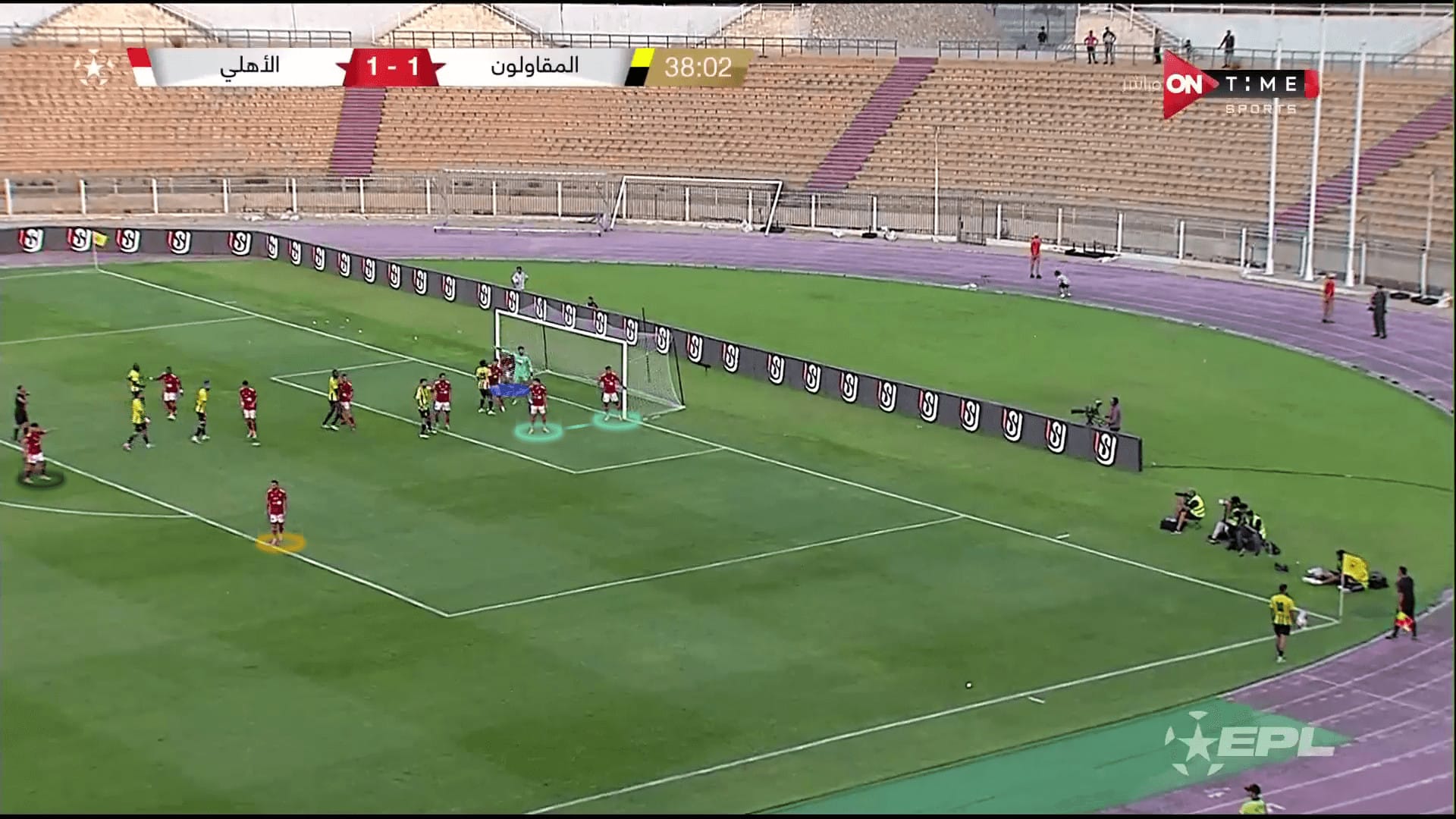
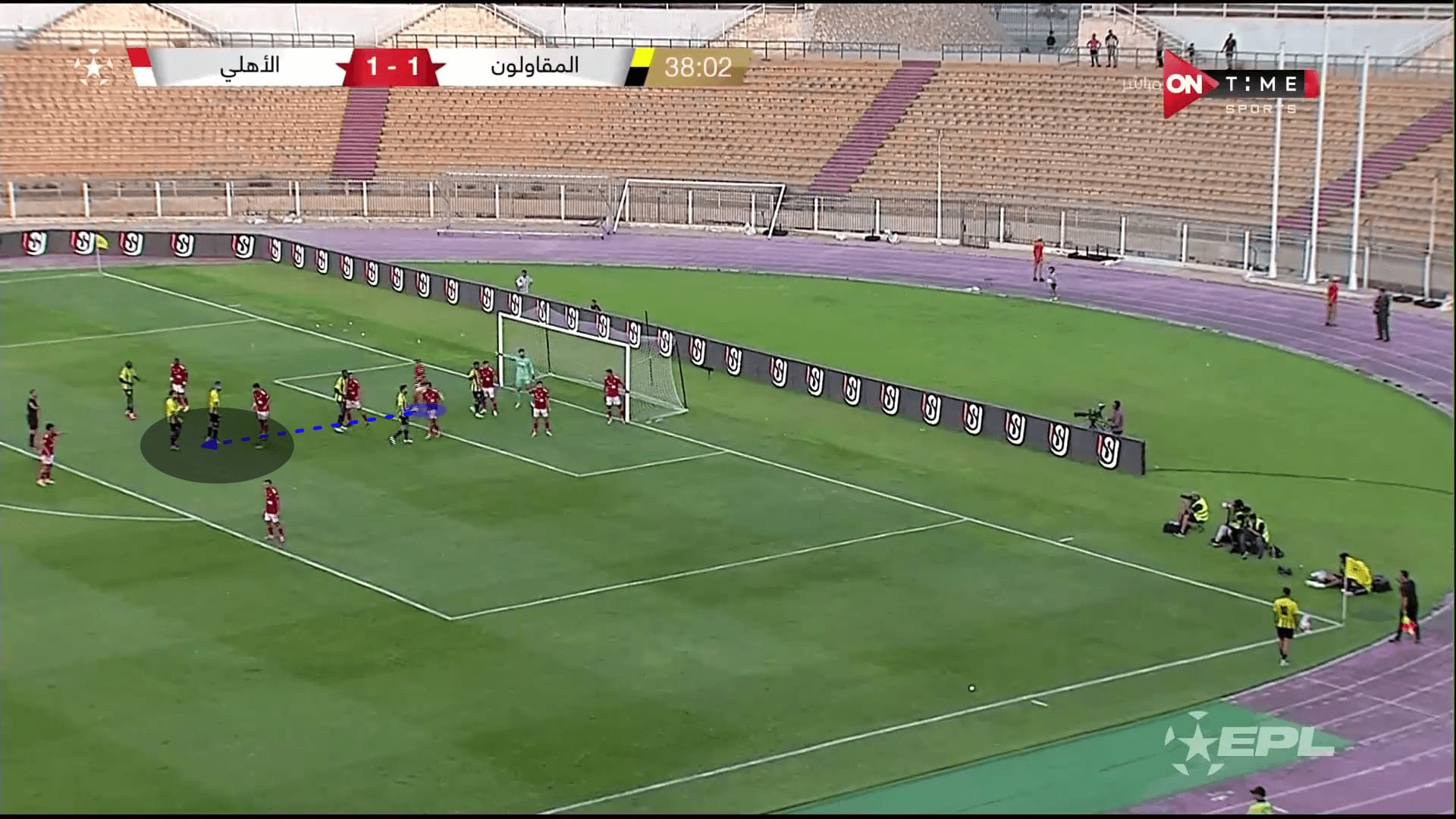
Al Ahly depend on the two zonal players to defend the near post — a valuable area to ensure is safe if any attacker escapes from his marker, as shown below.
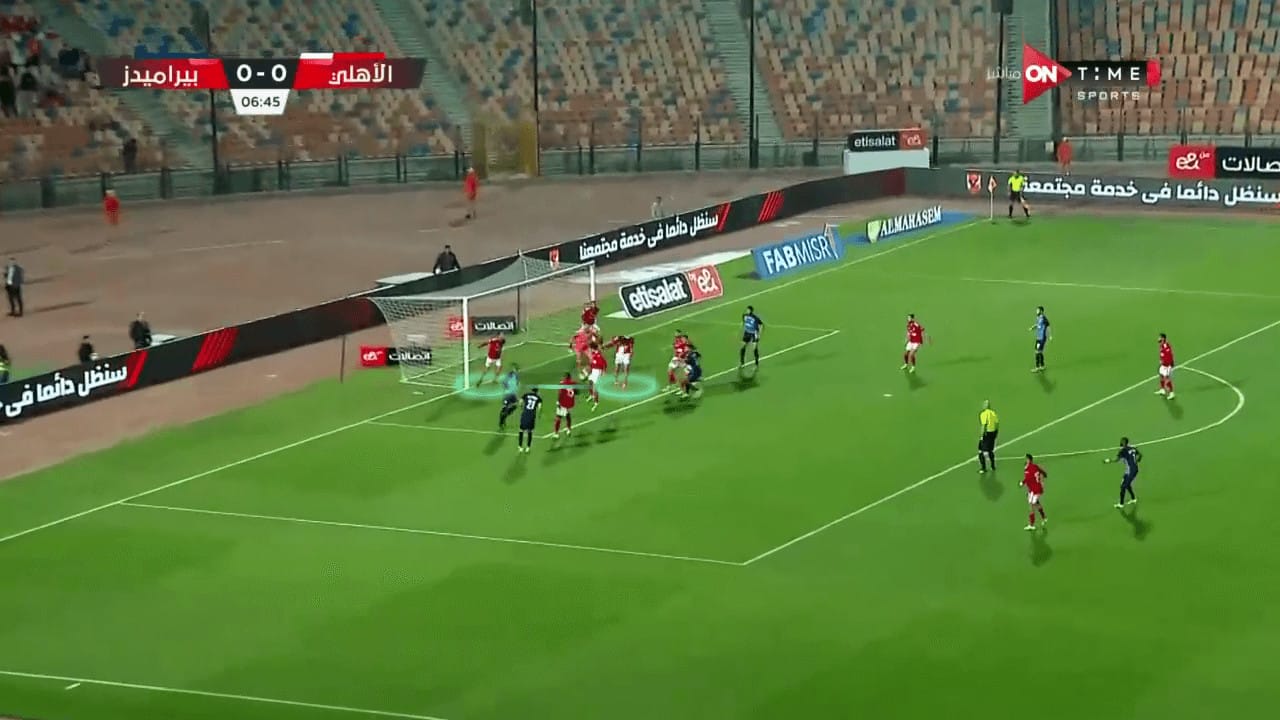
They depend on their goalkeeper, Mohammed El Shenawy, to defend the middle of the goal and the far post or, let’s say, to get any ball that beats the two zonal players, as shown in the first photo.
He chases the ball in distant areas, as shown in the third photo, and although he is very clever at that, it is also risky, as shown in the fourth photo, where he can’t get the ball.
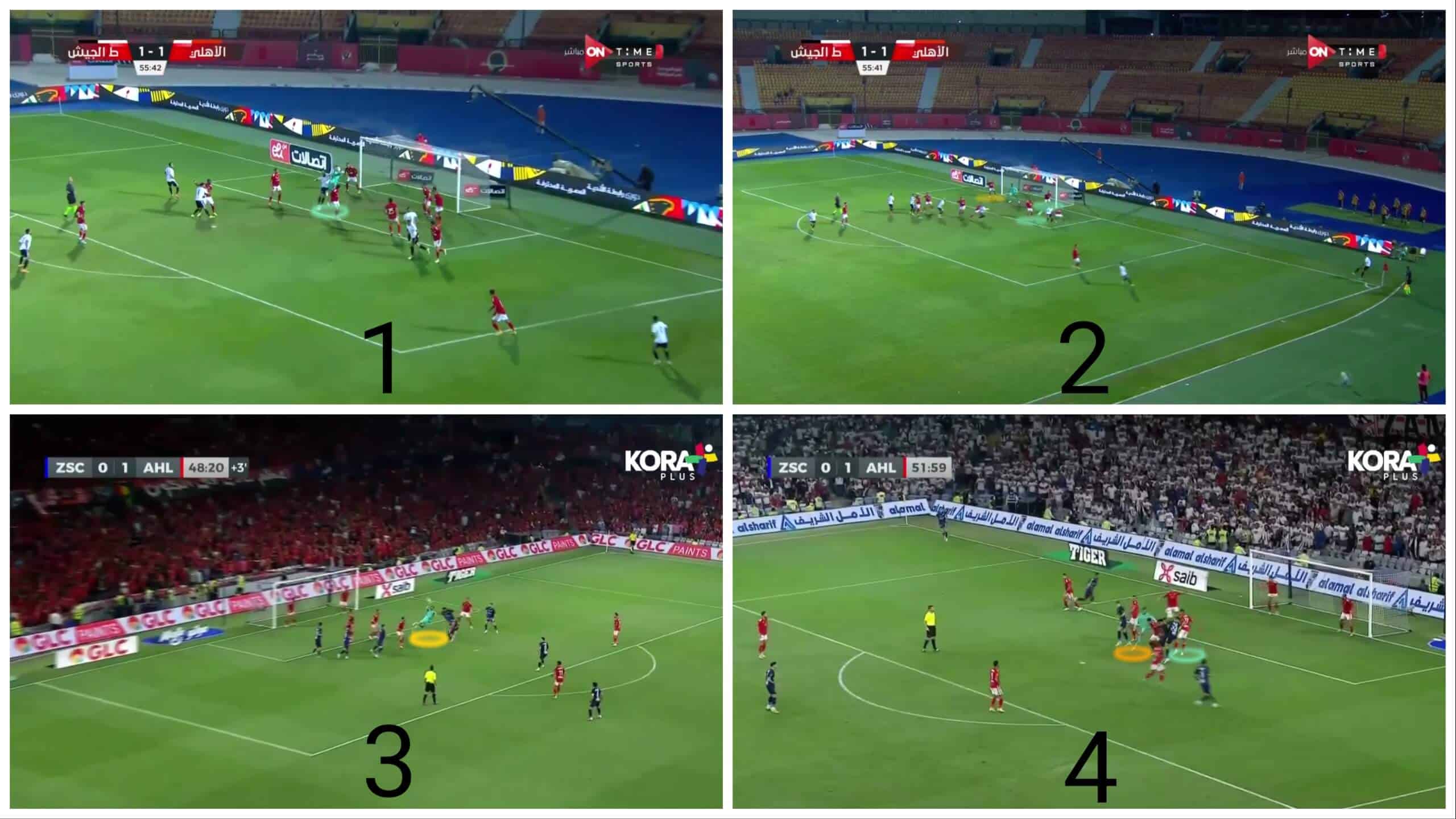
Sometimes, he hesitates when the cross is too far, which is too dangerous.
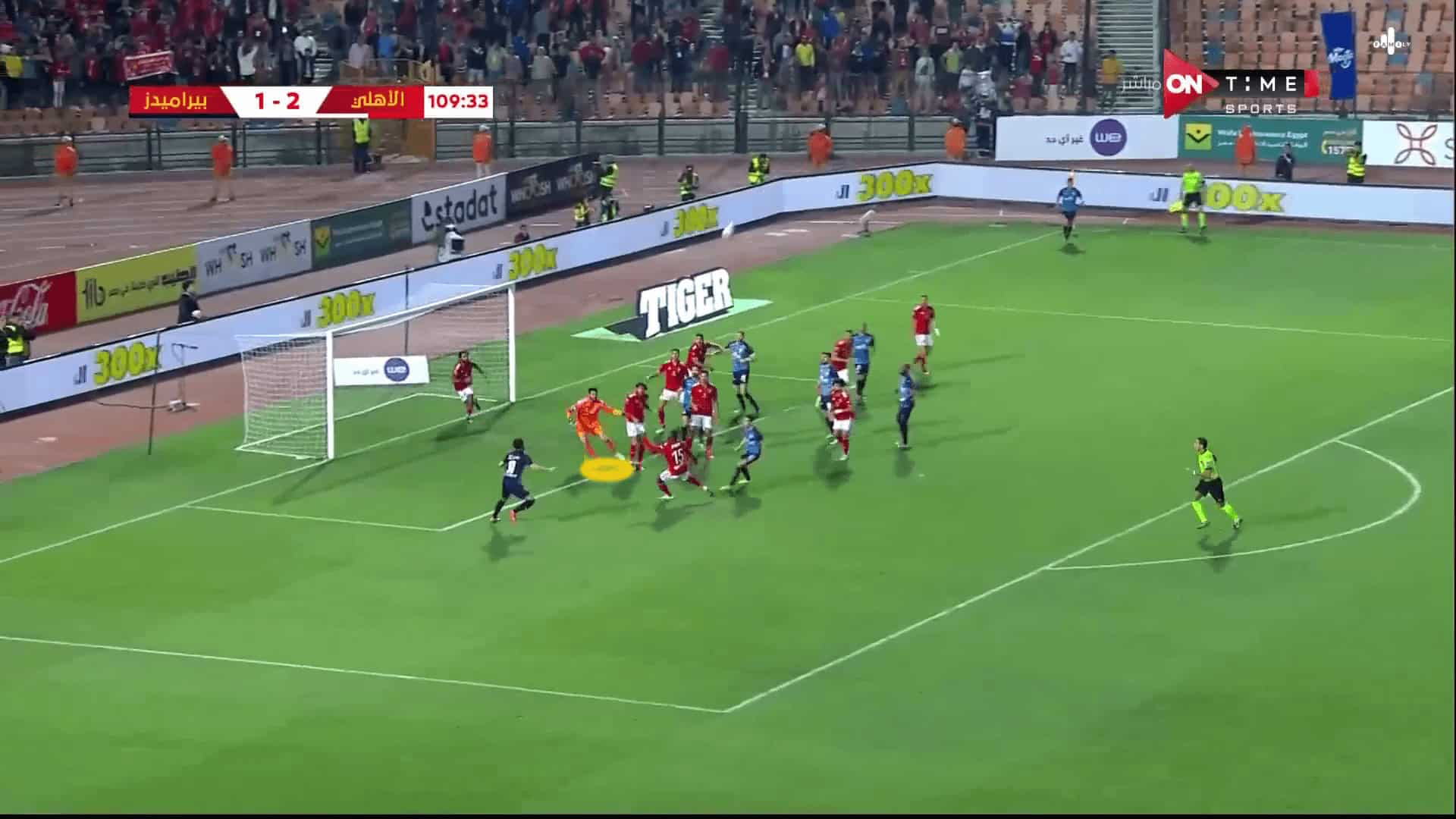
After understanding their system, we have two obstacles to overcome: the goalkeeper and the two zonal players.
Traffic in front of Mohammed El Shenawy
In the first photo, we can see four attackers dragging their markers, standing in front of Mohammed El Shenawy and preventing him from getting the ball.
In the second photo, when the ball gets closer, three players move forward, leaving only the targeted player who still stands in front of Mohammed El Shenawy to block him, so he uses his marker as a screen between him and the goalkeeper as shown in the third photo in which we see that they chose a strong player who can overcome his marker to block him, then jump — which is called a mismatch.
In the fourth photo, he connects with the ball, resulting in a goal.
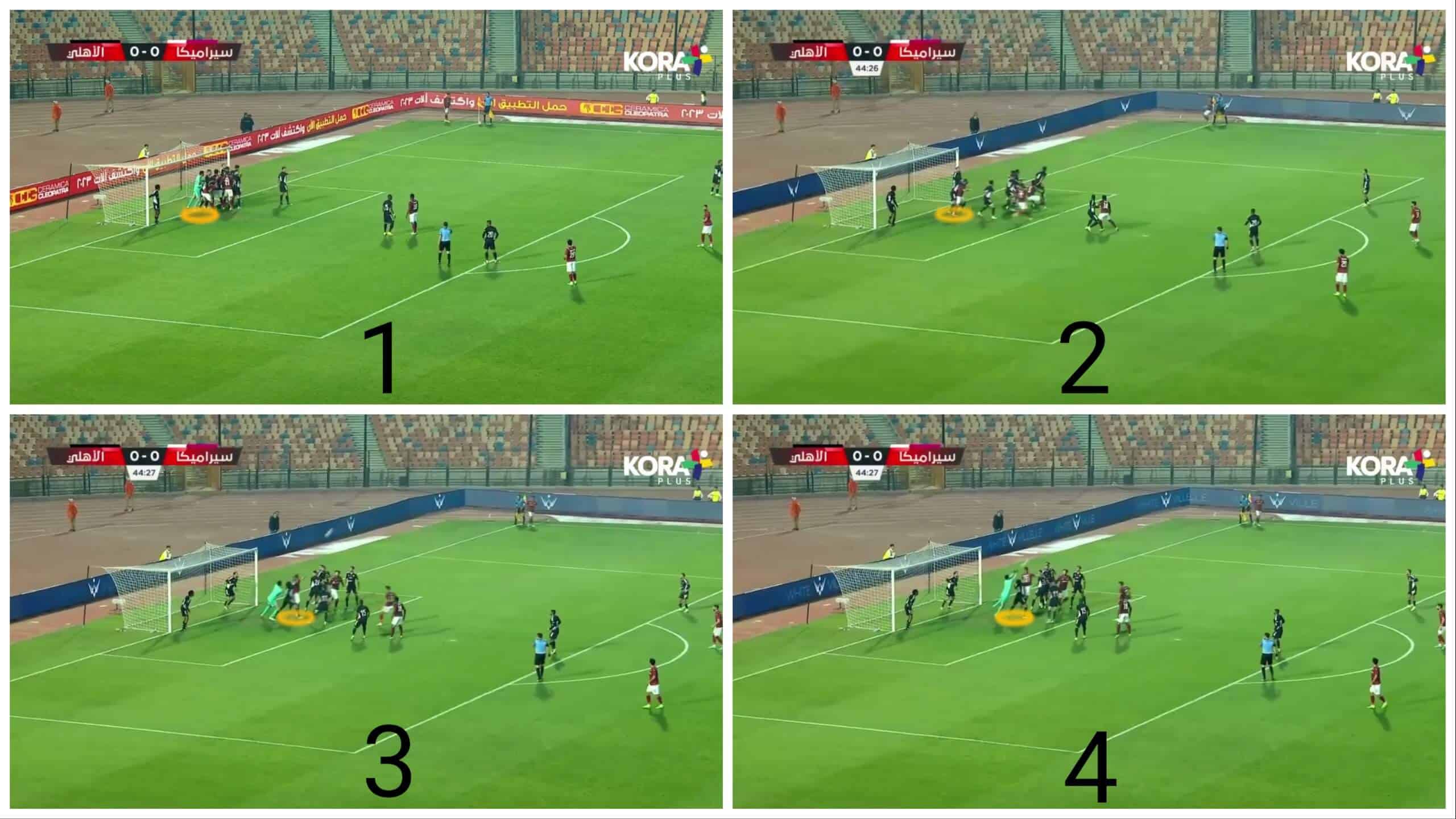
Targeting far areas by using floated and out-swinging crosses
Here, the opponent targets the area after the far post to be away from the goalkeeper, but let’s see how they overcome man-markers.
To overcome the man-marking system, Raja Club Athletic chose to use floated crosses. In the first photo, you can see the height of the ball in blue. The targeted player, in yellow, starts to move right to be at the defender’s back after playing the corner to make it difficult for his marker to follow him and the ball at the same time due to the floated cross taking a considerable amount of time in the air. This gives the attacker time to move and measure the ball, knowing that the attacker knows the plan and where the ball falls, but the defender doesn’t.
In the second photo, the defender has an orientation problem in yellow, while the goalkeeper, in black, can’t chase the ball because it is far away. In the third photo, the second part of the plan appears where the defenders, in red, leave their markers, making the blue-targeted player free to receive the headed pass, but the far-post defender moves forward to solve the problem.
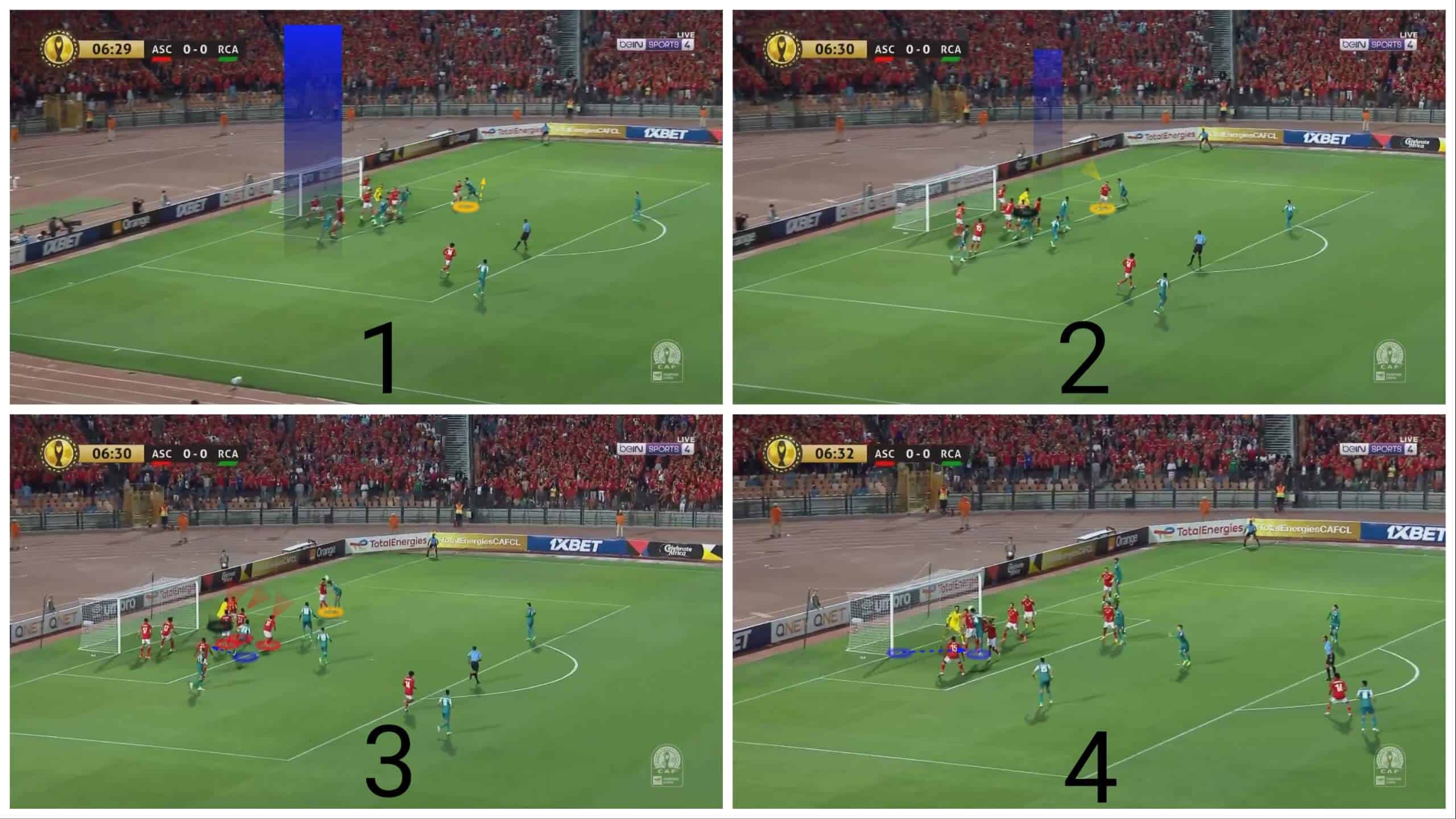
Here, Pyramids use an out-swinging cross to cause the same orientation problem for the marker and to be far from the goalkeeper.
In the first photo, the targeted player, in yellow, waits for the out-swinging cross in green. He starts to move right, dragging his marker, and then changes his direction to the far post as the taker plays the cross, so his marker loses contact with him and can’t track him and the ball simultaneously, as shown in the second photo. In the third photo, he gets the ball while the attackers drag their markers to the near post, but the goalkeeper saves the ball, as shown in the fourth photo.
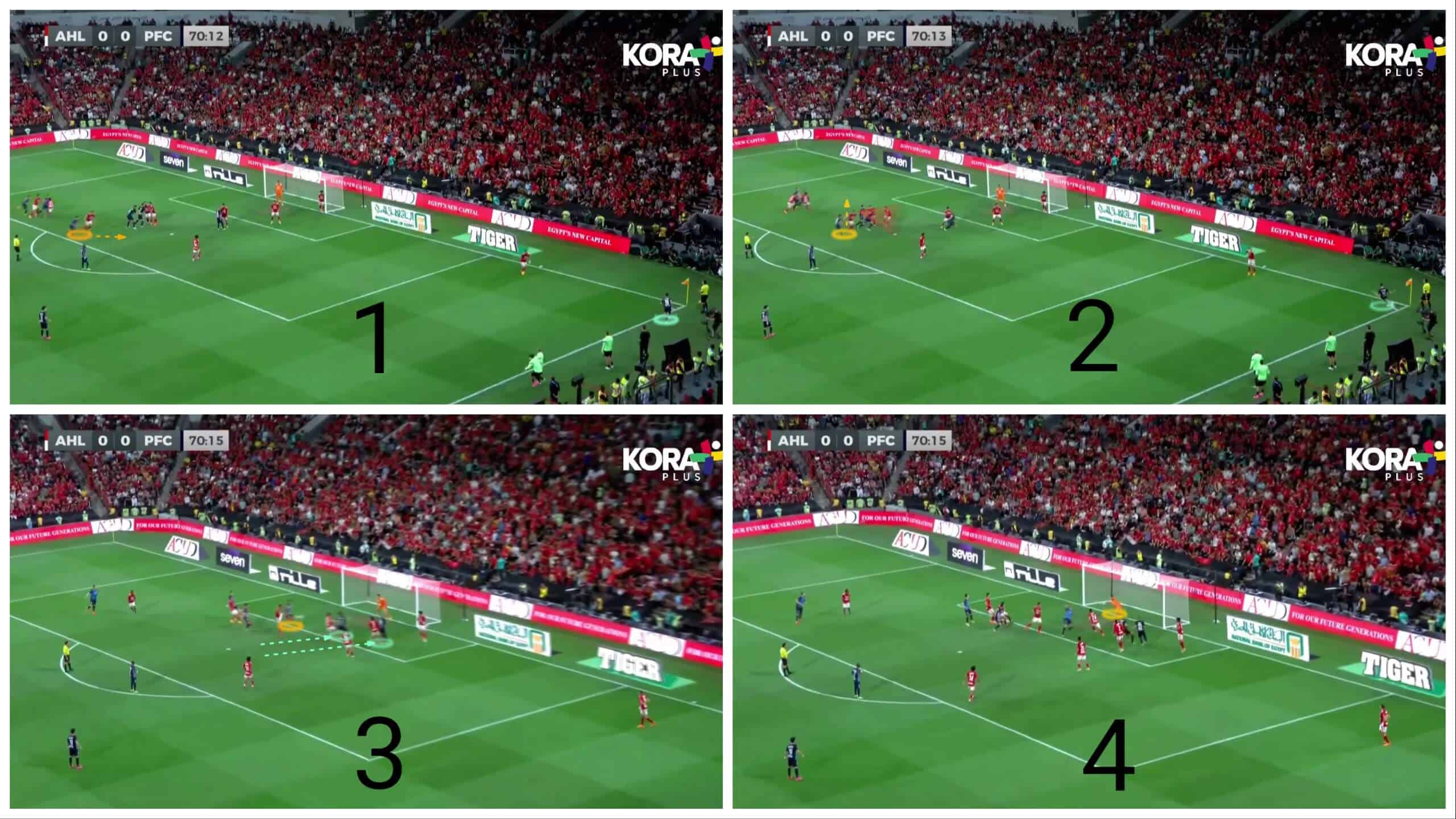
Now, you can ask why the out-swinging crosses cause this orientation problem while the in-swinging crosses don’t so that you can see below the path of the in-swinging cross, in green, and the defenders in the black area.
In this path, the defenders can stand in the correct position, which is inclined to the taker giving their backs to their goal to track the ball and the opponent simultaneously at every moment.
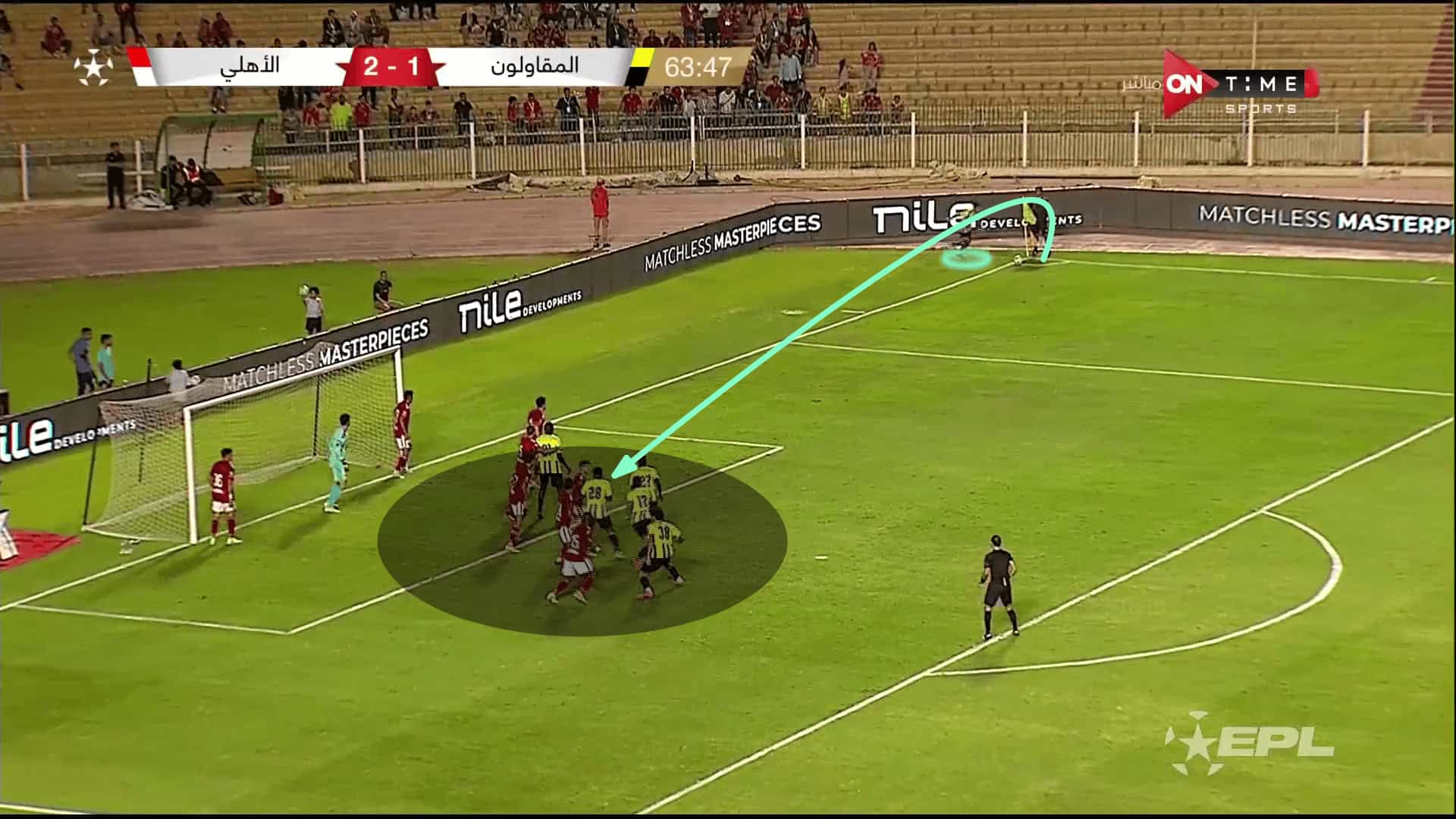
Overloading
Some teams resort to overloading the targeted area with their strongest players in aerial duels to overcome man-marking.
In the first photo, a player is standing with his marker in front of the goalkeeper, making it difficult for him to get out. In the second photo, the targeted area is covered in black. When the taker touches the ball, the green player pushes his marker towards the goalkeeper to hinder his movement. Then he moves to the targeted area with Zamalek’s best players in aerial duels, as shown in the third photo, but the ball hits the crossbar.
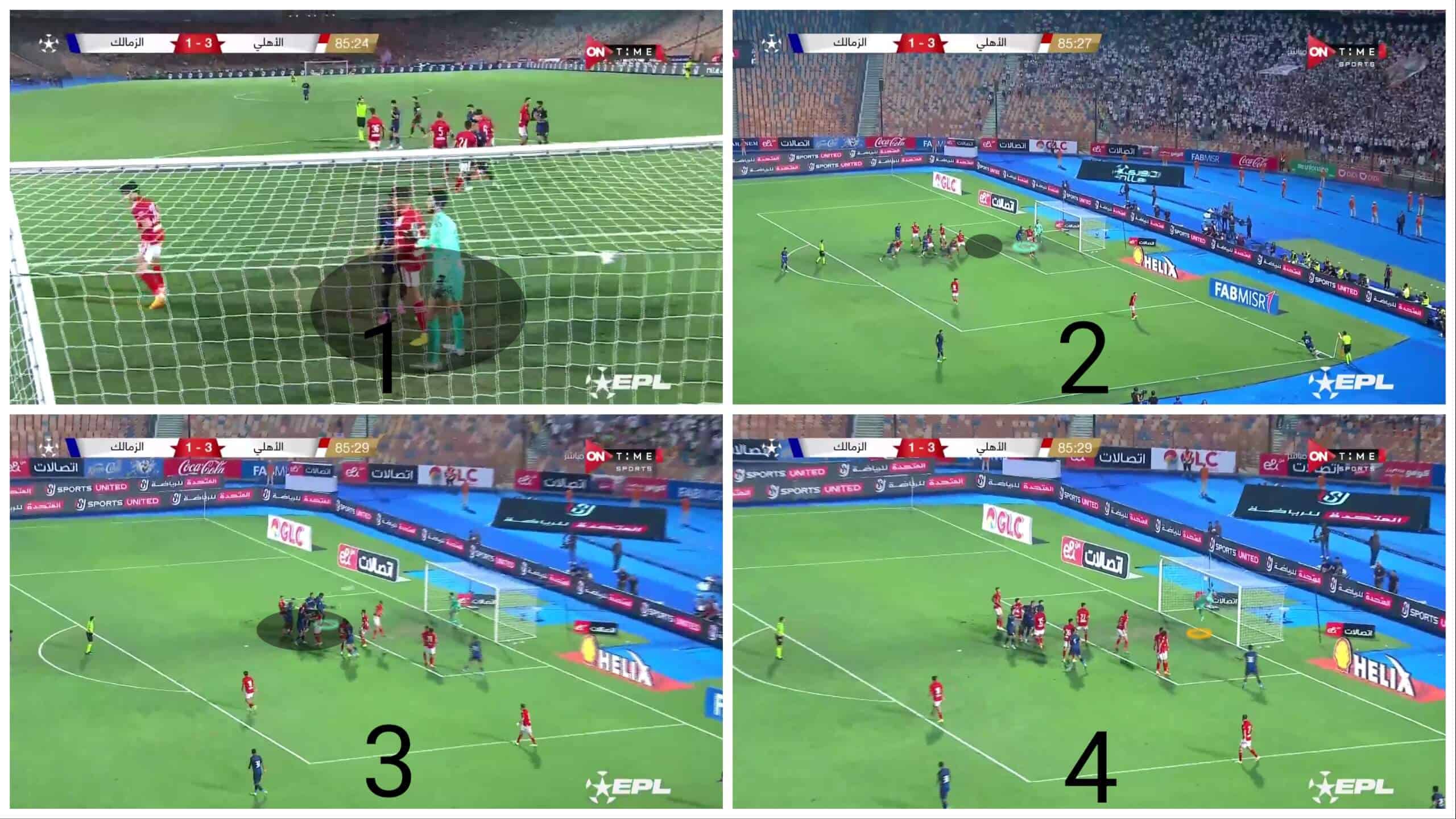
In this corner, Al-Masry carried out many of the previous principles scoring a goal in the quarter-final of the Egyptian Cup. Firstly, the attackers wait for the out-swinging crosses starting far from the goal to run to the targeted area at the edge of the box, which gives them the power to jump, achieving the mismatch over the markers.
Then, the targeted player waits a moment before moving as his marker can’t see him because of the out-swinging cross; this also generates a distance between them to jump, as shown in the third photo. The result is a goal.
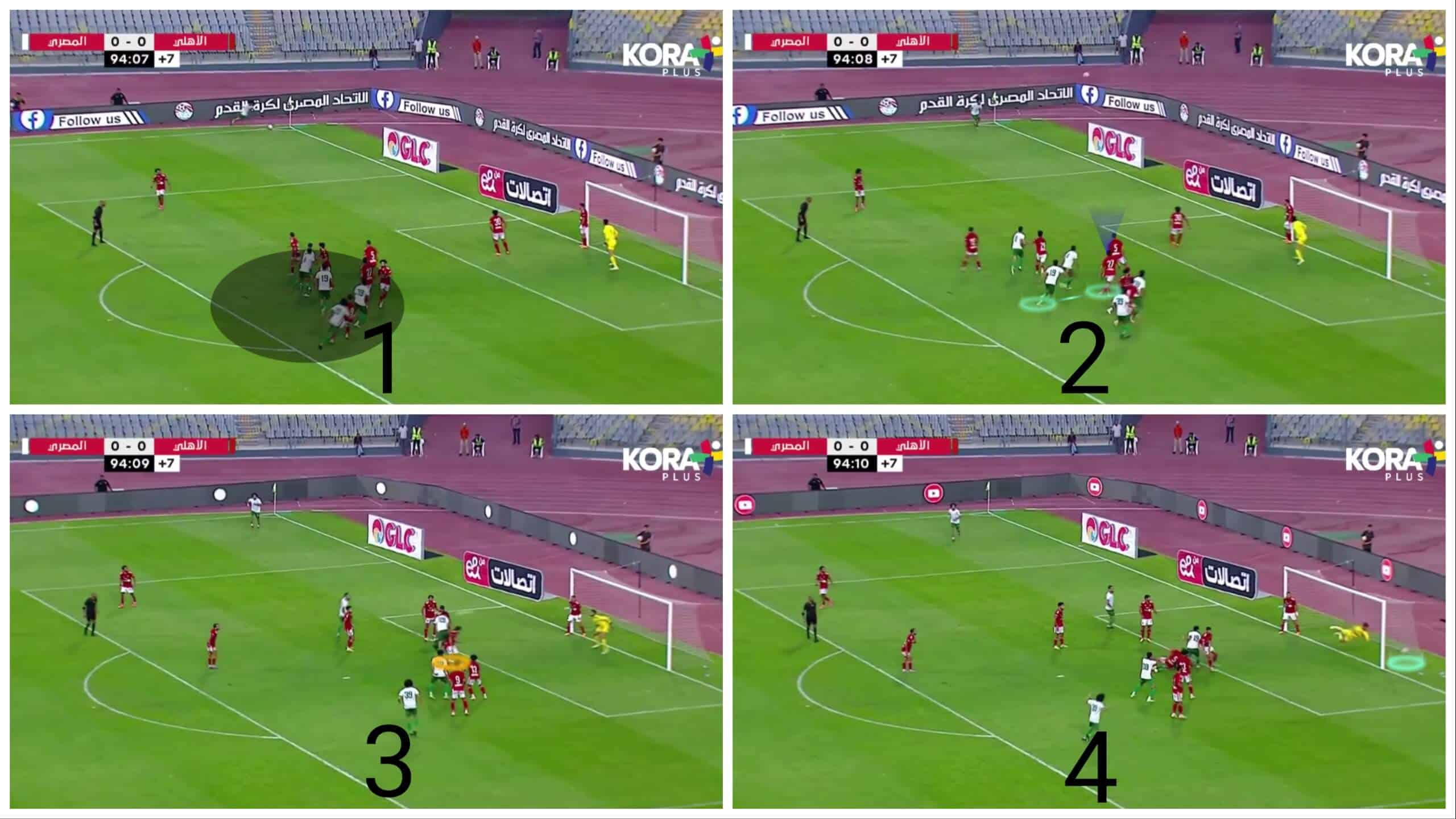
Using a rebound-player
We have mentioned that Al Ahly defend with two zonal players, a short-option player, a rebound player and a maximum of six man-markers, so in the first photo, Pyramids attack with six players in the box in green while the targeted yellow player acts as he is a rebound-player.
In the second photo, he attacks the empty area after playing the corner because the attackers dragged the markers to the near post. He shoots the ball quickly, but the near-post defender moves to save the ball.
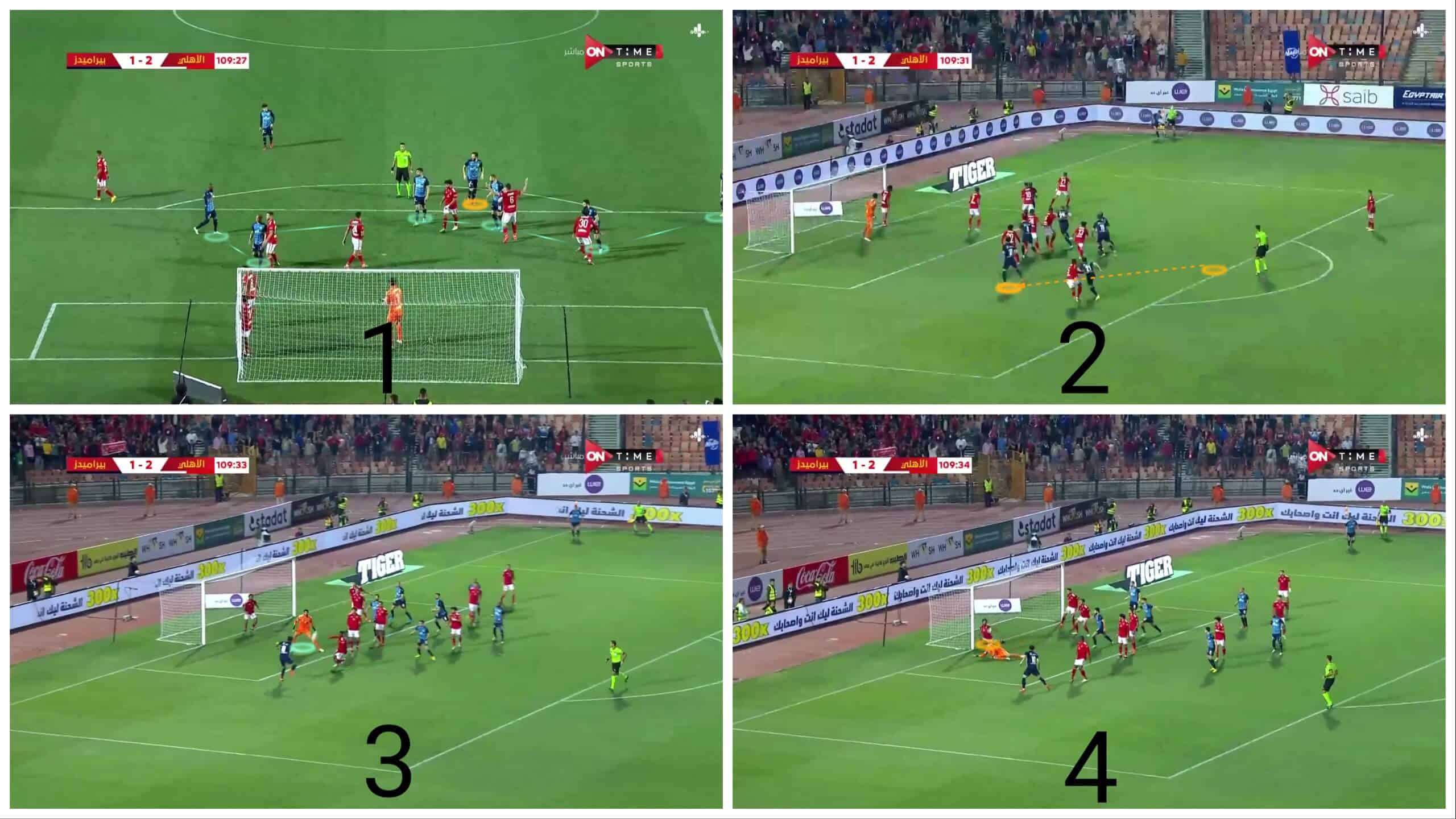
Using flicks
Now we get to the second kind of plan, which aims to get the first touch before the two zonal players; the most common method is using flicks.
Initially, one of the best players in aerial duels moves to get the first touch in the area in front of the two zonal players. In the third photo, the second targeted player gets the flicked-headed pass easily while defenders focus on the ball, leaving their markers at their backs, but the headed shot is out above the crossbar.
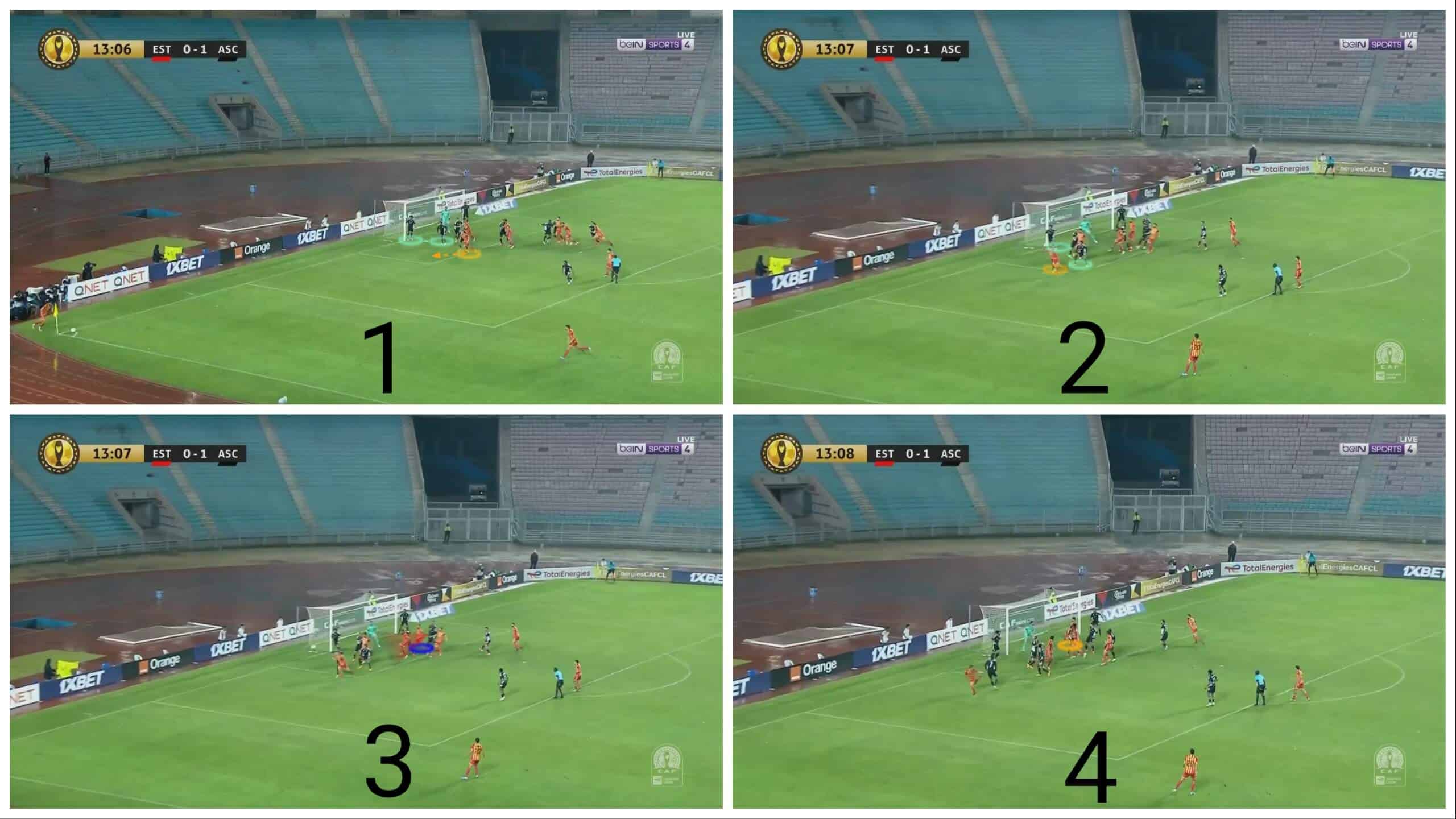
This depends mainly on a mismatch to get the first touch, and we suggest a different routine. As shown below, when an attacker from the box moves to receive a short pass or to do a flick, the near post player follows him, leaving only one player as a zonal marker.
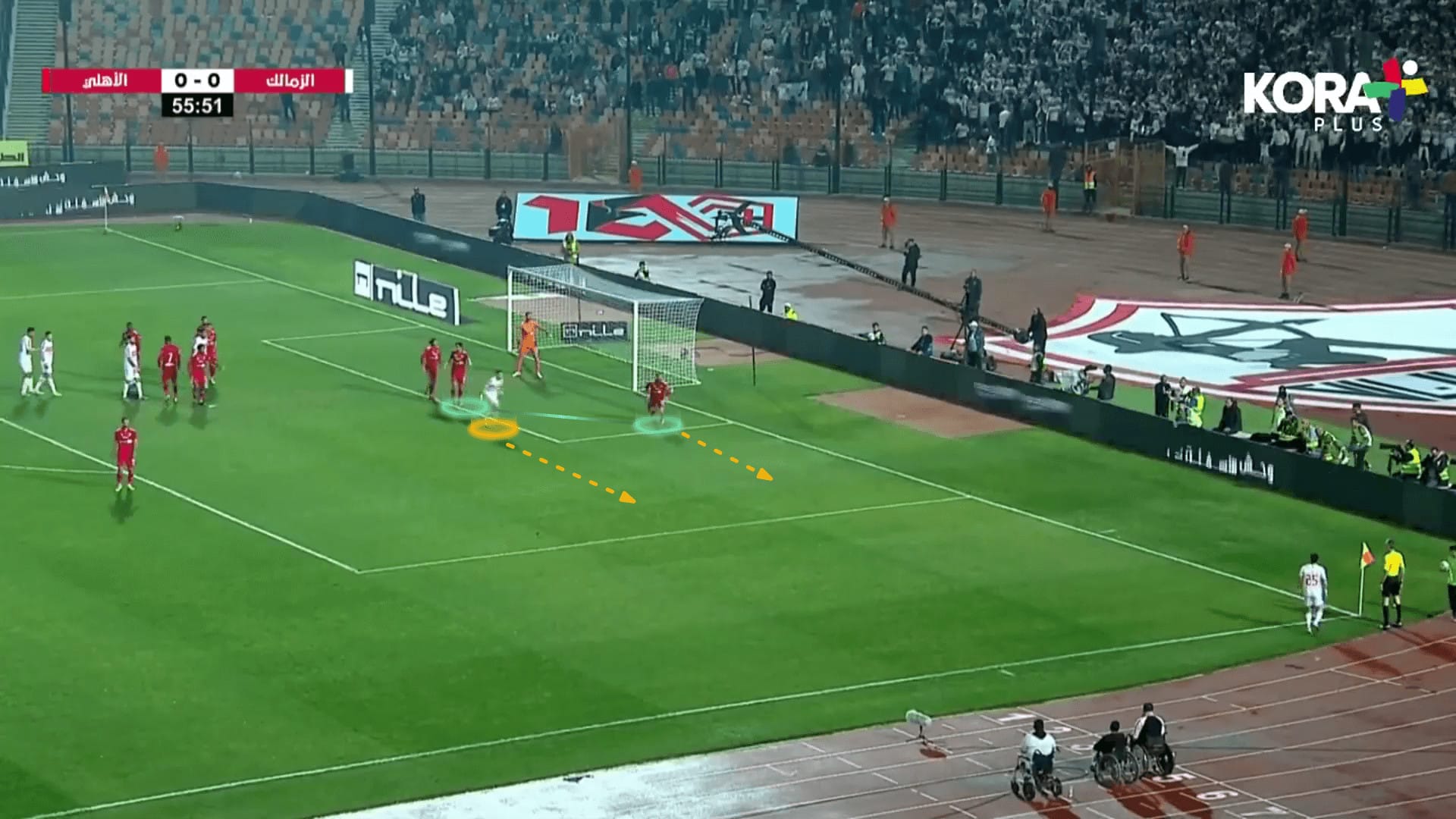
Depending on the previous note, we suggest this routine.
In the first photo, Nottingham Forest’s defensive scheme is shown below. With two zonal markers (in green), one of them helps the player on the edge of the box (in yellow) to defend the short corner, while another player (in black) stands in the rebound zone.
They’ve got five man-markers and a player positioned just behind, anticipating the counterattack. Saka moves acting like he will receive a short pass dragging one of the two zonal players who stepped a little forward to prevent a 1v2 situation, so the flick area is less protected.
In the second photo, Ben White moves towards this space, using Nketiah (highlighted in green) as a screen in a small stack to escape from his man-marker. In the third photo, Jesus (highlighted in green) uses the principle of orientation that we have mentioned. He started at the defender’s blind side, then moved after White’s flick but missed the ball, as in the fourth photo.
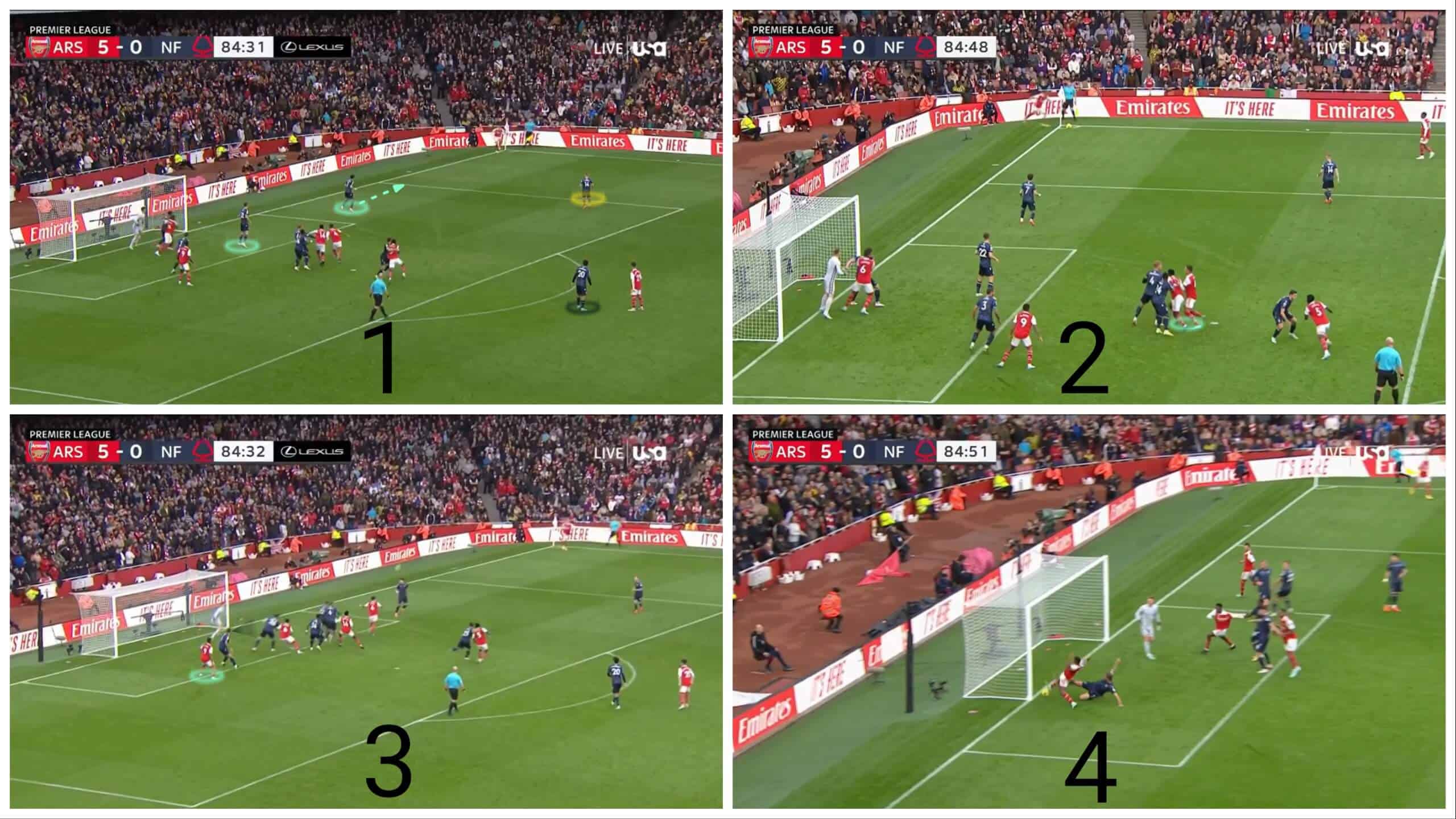
Now, we know the weaknesses in Al Ahly’s system in defending corners. These are the disadvantages of the man-marking defending system, and a few teams succeeded in overcoming this system.
Indirect free-kicks
In indirect freekicks, Al Ahly resort to the same man-marking system but with a different style than usual.
Al Ahly start to defend with a standard high line leaving a blue player behind them in an off-side position, but after the movement of the attackers, we can see the defenders act as man-markers which is too dangerous because the green-highlighted defender covers the offside, so the blue attacker is onside and has a positional superiority over his marker. In this way, you can’t achieve the purpose of the high-line system and also can’t defend freely in the man-marking system as in the third photo, where every defender follows their man without line restrictions.
In the end, the free attacker gets the ball easily.
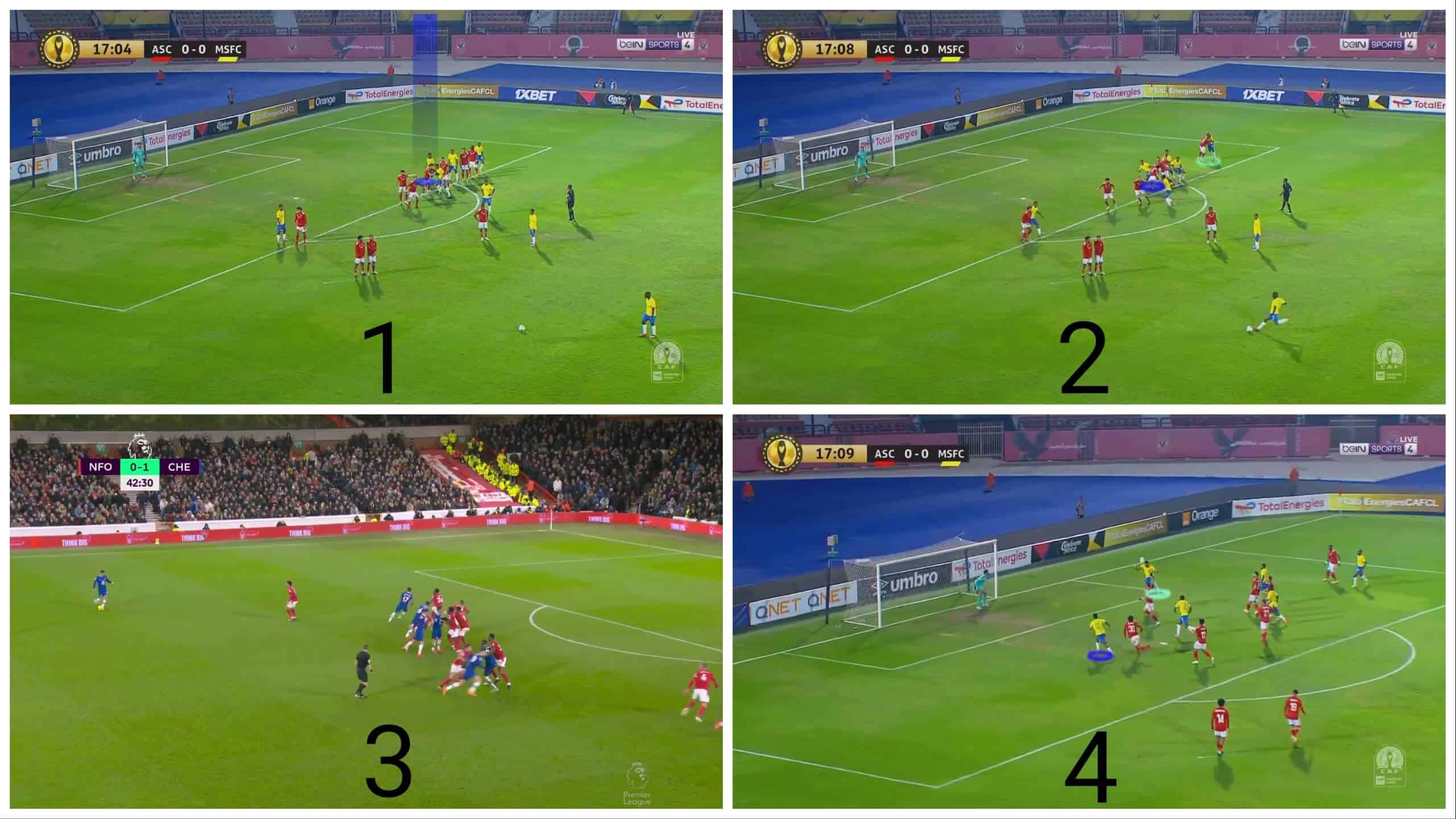
The referee ruled it offside, but he seems onside, as shown below, where the green defender covers the offside, and the blue attacker has positional superiority over his marker.
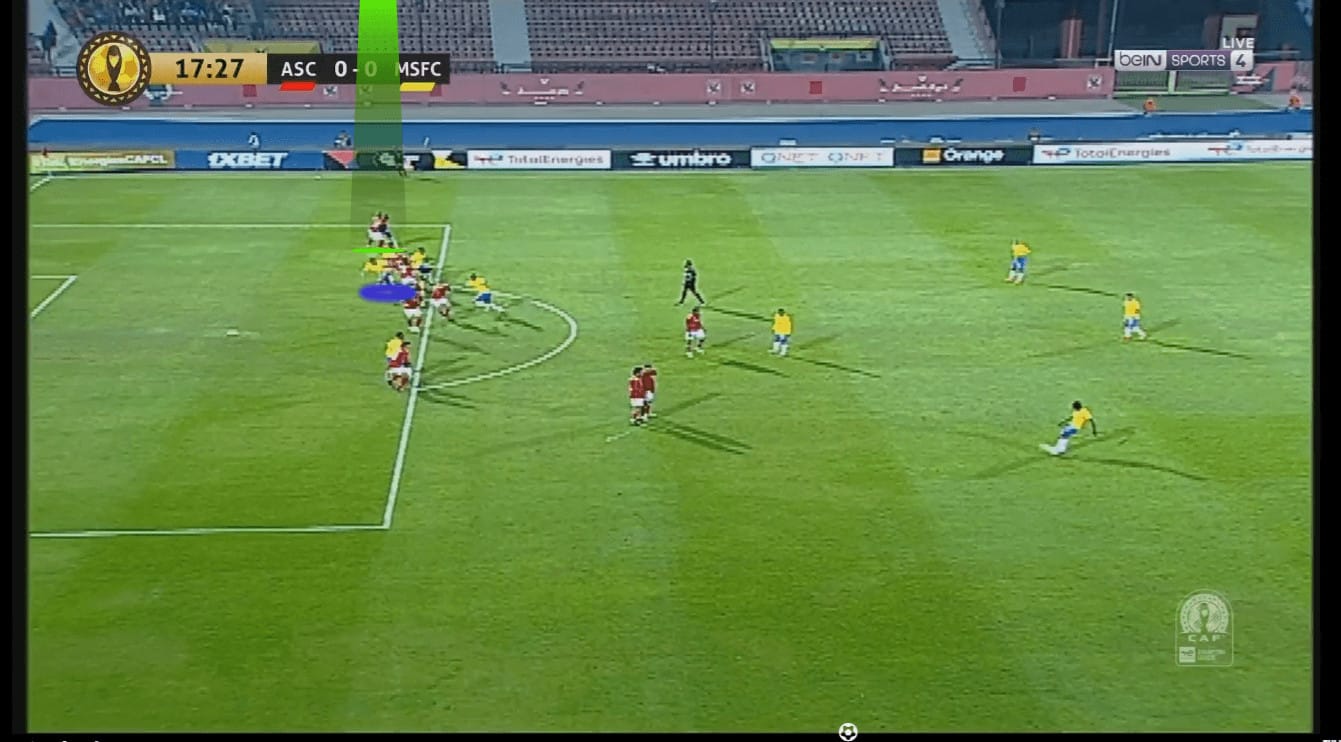
Here, the second problem appears which is when the opponent overloads the far post, the line is divided into two parts, the first two defenders, in green, and the rest of the defenders on the far post, so you can see the yellow attacker stands with his marker, who leaves his position in the line to mark him, so he will attack the space the defender left running behind the first two green players.
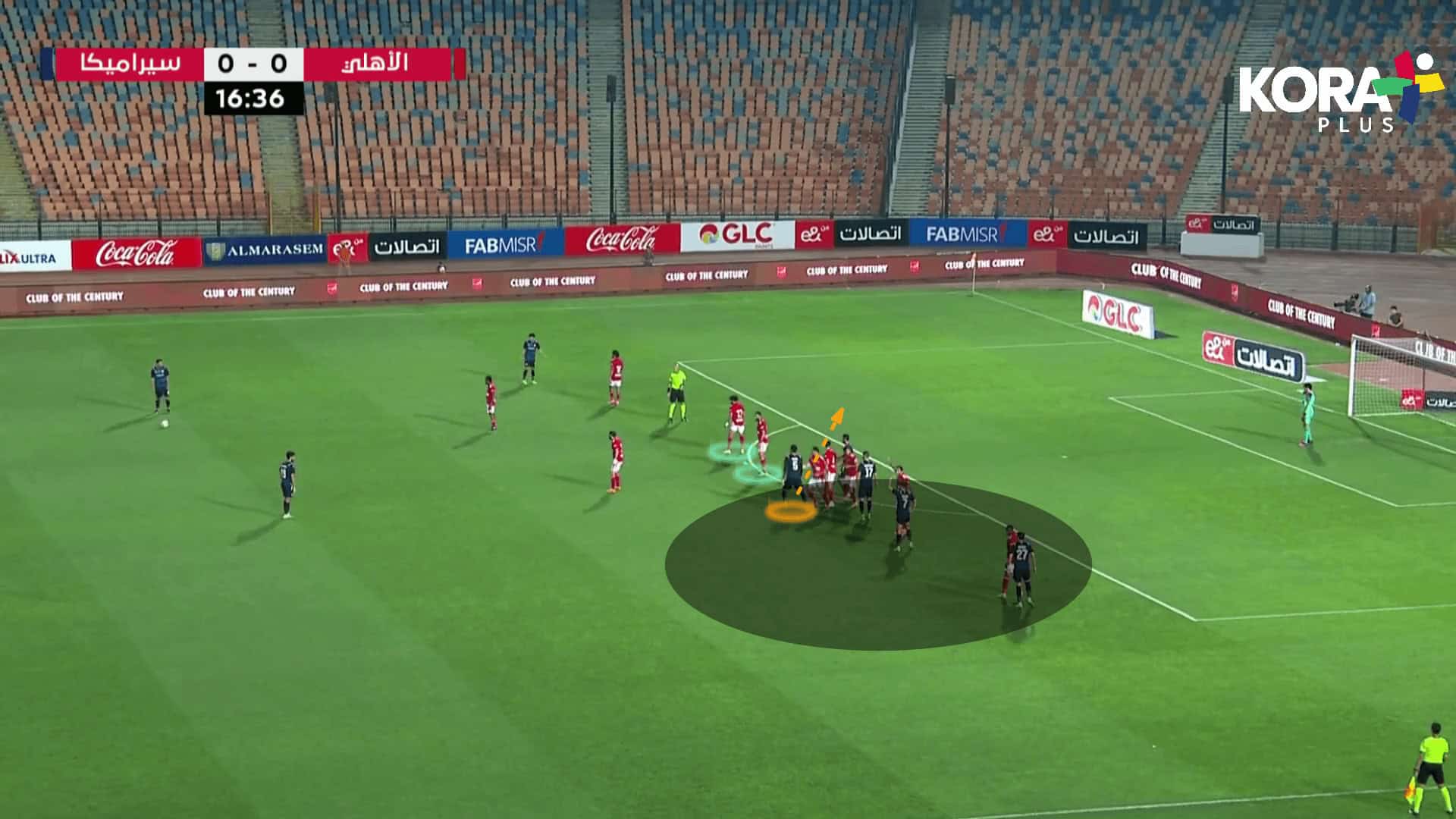
The cross was short, so the second defender got the ball.
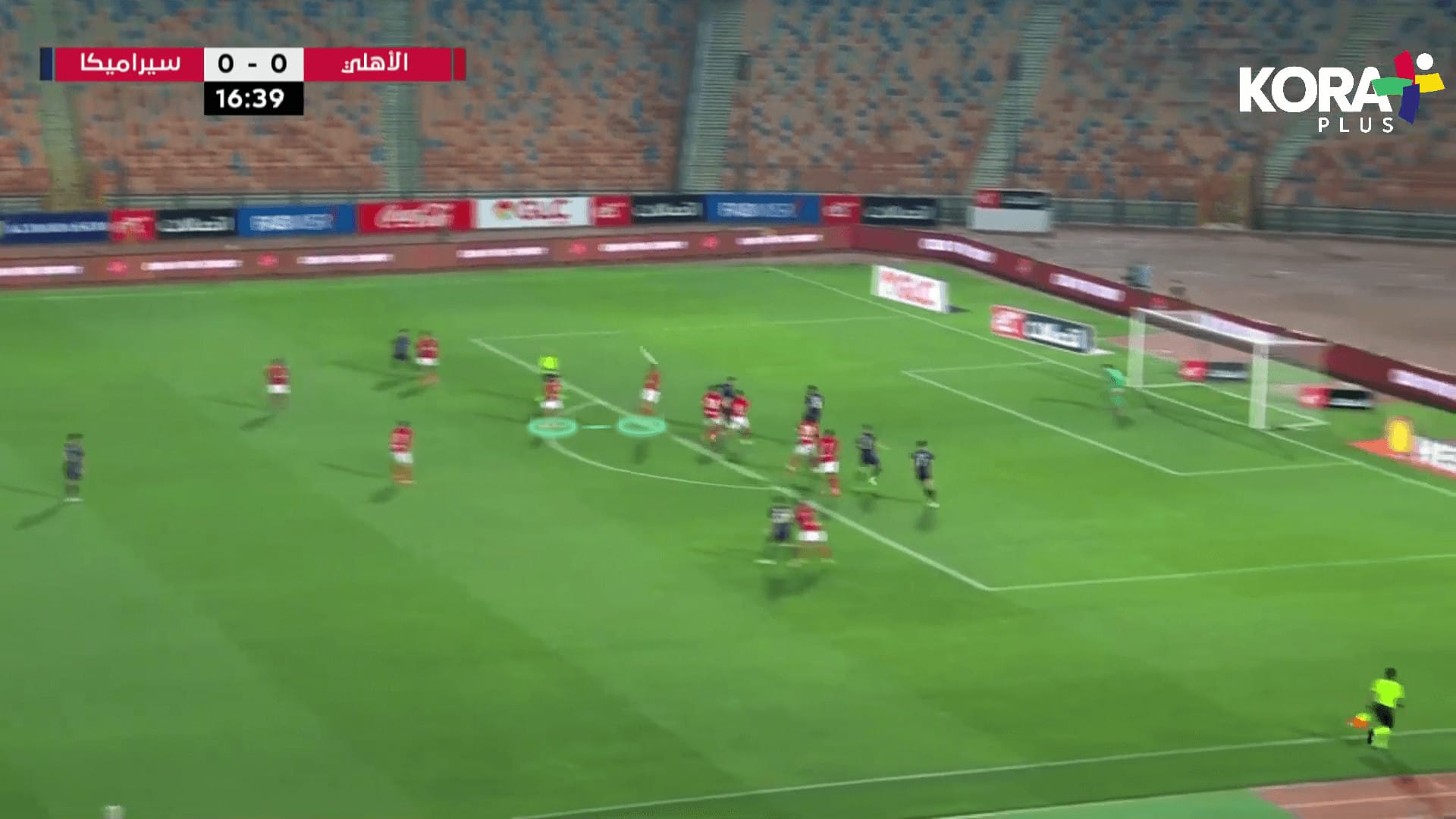
In the final of the CAF Champions League, Wydad Athletic Club performed a routine with the two previous ideas, scoring a goal as a result.
Al Ahly were defending with a player as a wall, a player for the short option and a player on the rebound, leaving seven players remaining. Wydad overloaded the far post with five players against five from Al Ahly, leaving the first two players alone in green while the sixth attacker, in black, is free behind them because he isn’t good at aerial duels.
In the second photo, when the taker touches the ball, he moves behind them, creating positional superiority.
In the third photo, the second matter is shown: the green marker’s early movement makes the attacker onside. He can easily move behind the first two defenders, who stick to the line-defending system. He probably didn’t touch the ball, but his movement confused the goalkeeper.
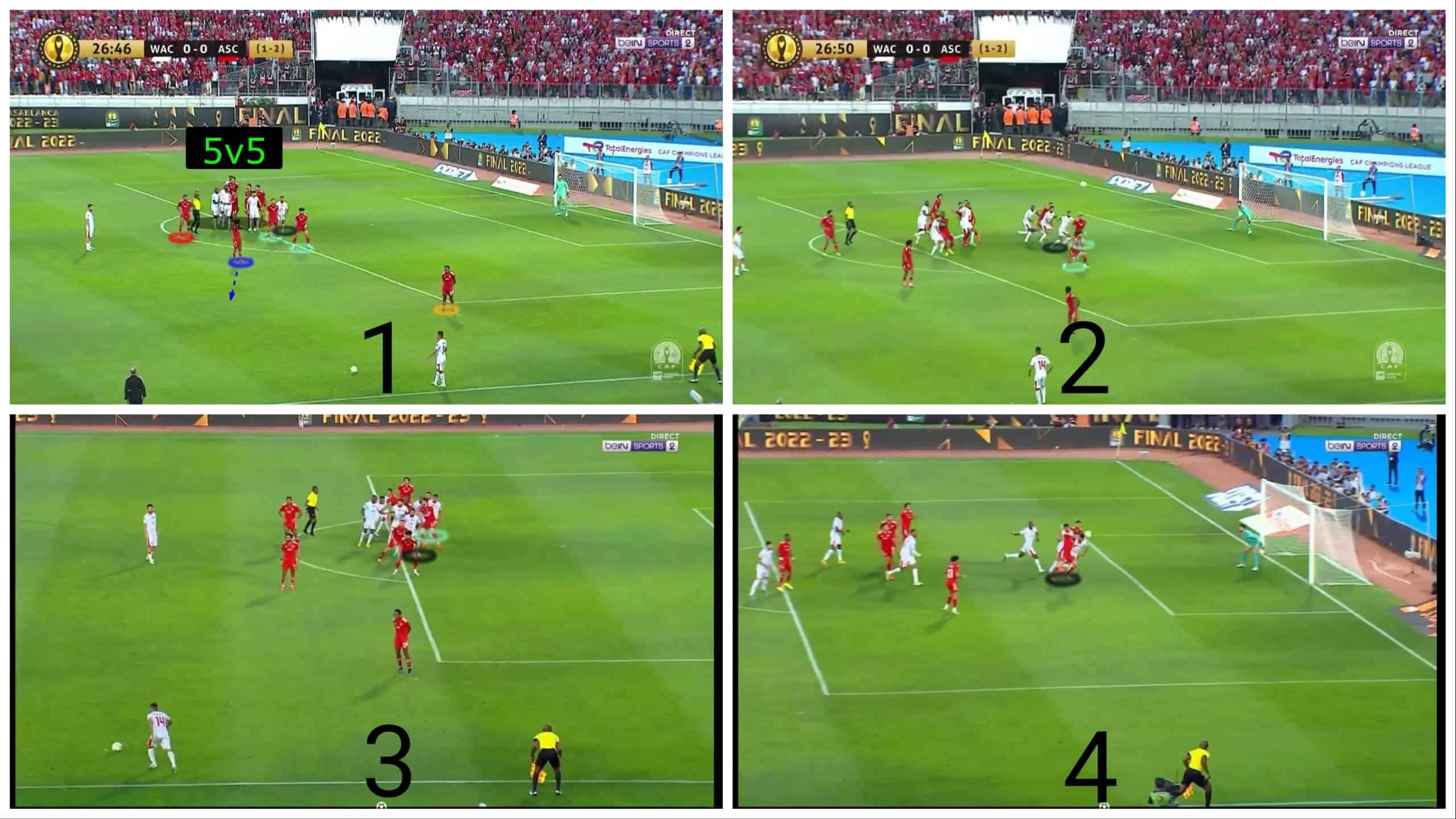
We should mention another trick: they overloaded the middle, leaving the last defender out of the game, so they have a free player who also goes to receive the cross.
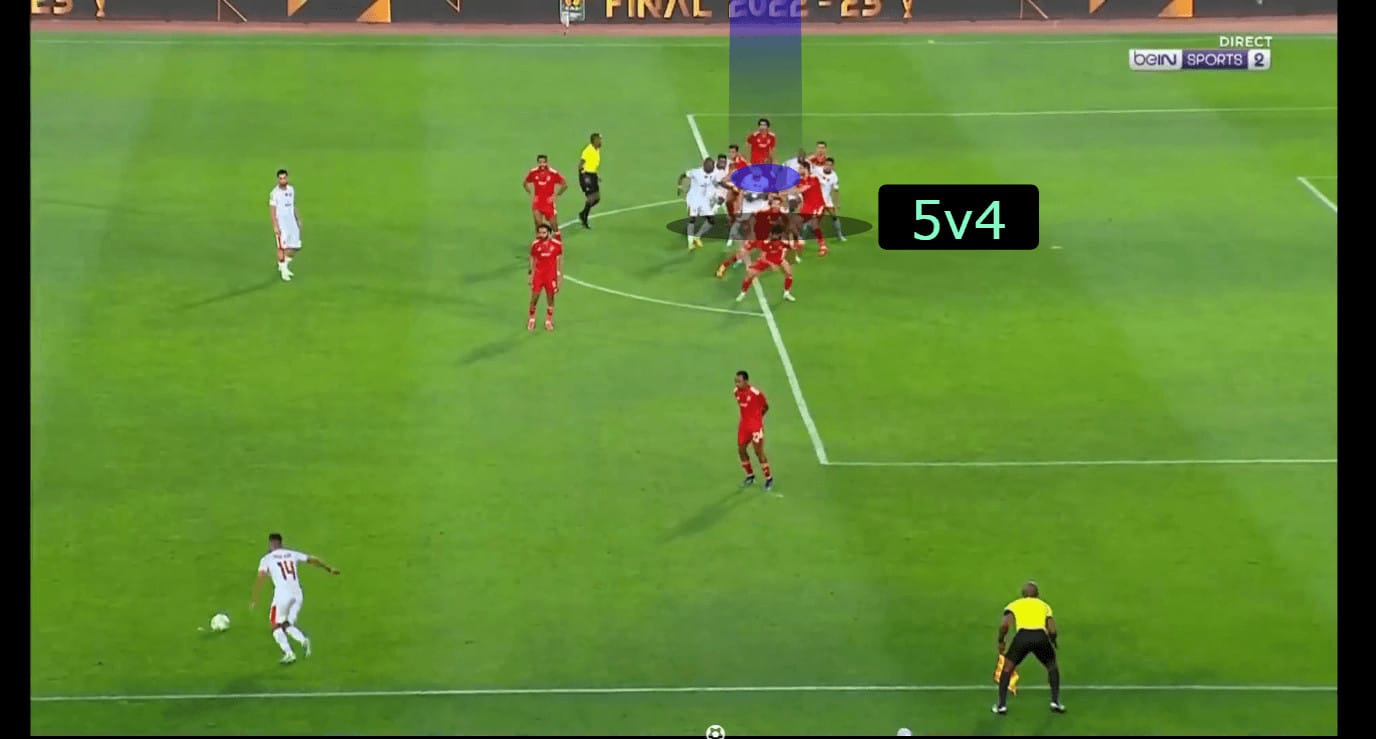
Conclusion
In this analysis, we have explained the gaps in Al Ahly’s systems in defending set pieces and how opponents can overcome this system. Ultimately, we’d suggest changing this man-marking system because succeeding in a high line from the goal is difficult.






Comments